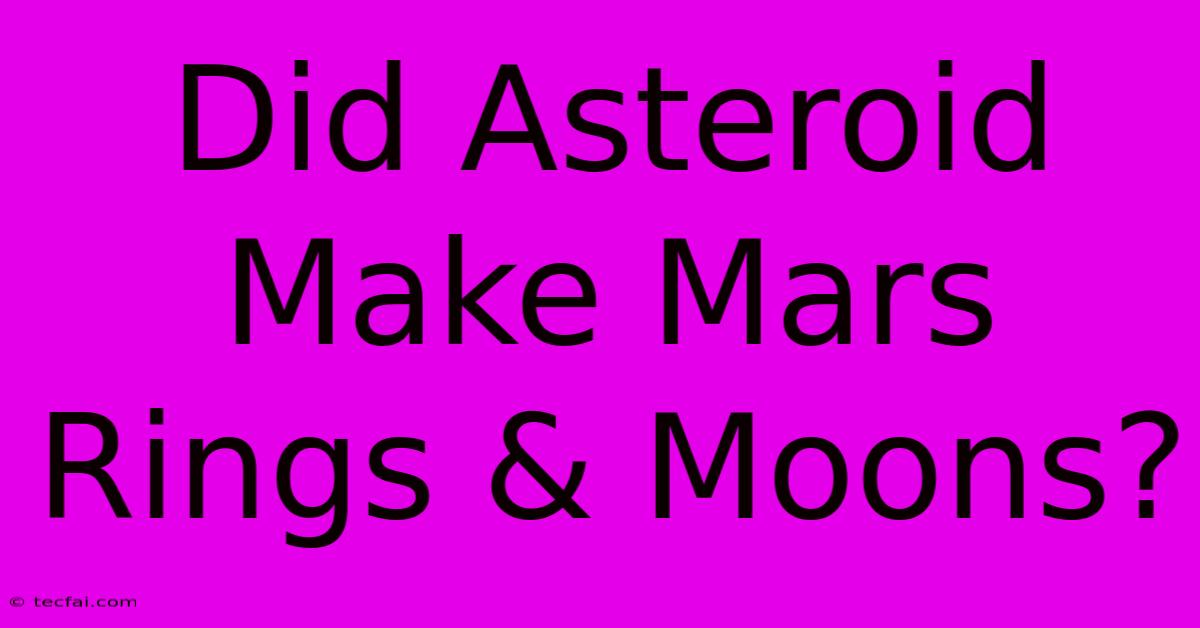Did Asteroid Make Mars Rings & Moons?

Discover more detailed and exciting information on our website. Click the link below to start your adventure: Visit Best Website tecfai.com. Don't miss out!
Table of Contents
Did an Asteroid Make Mars' Rings and Moons? Unraveling the Martian Mysteries
Mars, the red planet, continues to captivate our imaginations. While we know it boasts two tiny moons, Phobos and Deimos, the possibility of past rings, and the role asteroids may have played in shaping its current configuration, fuels ongoing scientific debate. This article delves into the fascinating hypothesis that an asteroid impact could be responsible for both Mars' current moons and any potential past ring systems.
The Curious Case of Phobos and Deimos
Phobos and Deimos, Mars' moons, are oddly shaped and small, unlike the larger, more spherical moons orbiting other planets in our solar system. Their irregular forms and relatively close proximity to Mars have led scientists to speculate about their origins. The prevailing theory suggests they aren't native to Mars but rather captured asteroids. This capture process, however, raises more questions. How were these asteroids captured, and could this capture be linked to a larger event, perhaps a catastrophic asteroid collision?
The Asteroid Impact Hypothesis: A Ring of Fire?
The leading hypothesis suggests a massive asteroid impact in Mars' distant past could explain the existence of Phobos and Deimos. This impact would have ejected a significant amount of Martian material into orbit. This ejected debris, initially forming a vast ring system around Mars, gradually coalesced under its own gravity. Over millions of years, this debris accumulated, eventually forming the two moons we see today.
This scenario helps explain several aspects of Phobos and Deimos: their irregular shapes (reflecting the chaotic nature of debris accretion), their relatively small size, and their composition, which is thought to be similar to some types of asteroids. The hypothesis also provides a possible mechanism for the capture process, avoiding the need for a precise, unlikely gravitational interaction.
Evidence Supporting the Hypothesis
While direct evidence remains elusive, several lines of circumstantial evidence support the asteroid impact hypothesis.
- Phobos' Orbital Decay: Phobos is slowly spiraling inwards towards Mars. This suggests it's a relatively young moon, consistent with its formation from a relatively recent impact event. The decaying orbit ultimately suggests Phobos might eventually be shattered, creating another, albeit temporary, ring around Mars.
- Compositional Clues: Analysis of Phobos and Deimos’ composition through spectroscopic studies and future sample return missions could confirm the hypothesis by showing material matching the composition of Mars' crust and mantle.
- Computer Simulations: Sophisticated computer models simulating large asteroid impacts on Mars have successfully reproduced the formation of rings and subsequent moon formation from the resulting debris.
Challenges and Open Questions
Despite the plausibility of the hypothesis, several challenges remain:
- Precise Impact Parameters: Determining the exact size and trajectory of the hypothetical asteroid remains a significant challenge. Pinpointing the specific impact event is difficult due to the lack of direct geological evidence on Mars.
- Alternative Theories: While the asteroid impact hypothesis is leading, alternative theories proposing co-formation of the moons or capture from the asteroid belt still need to be fully ruled out. More research is needed to differentiate between the potential origins.
The Future of Martian Moon Research
Future Mars missions, including sample return missions to Phobos, will play a crucial role in testing the asteroid impact hypothesis. Analyzing the composition and structure of Phobos could provide conclusive evidence to either confirm or refute the theory. The exploration of Mars continues to reveal its fascinating history, and the origin of its moons is a key piece of this larger puzzle. Unraveling the mysteries surrounding Phobos and Deimos could significantly enhance our understanding of planetary formation and evolution throughout the solar system.
By studying Mars and its moons, we gain invaluable insights into the processes that shaped our own solar system and might even shed light on the potential for life beyond Earth. The ongoing investigation into the role of asteroids in creating Mars' current and possibly past ring systems remains a captivating aspect of planetary science, with discoveries on the horizon poised to revolutionize our understanding of the Red Planet.

Thank you for visiting our website wich cover about Did Asteroid Make Mars Rings & Moons?. We hope the information provided has been useful to you. Feel free to contact us if you have any questions or need further assistance. See you next time and dont miss to bookmark.
Featured Posts
-
Man Girl Injured In Ladbroke Grove Shooting
Nov 26, 2024
-
Drakes Team Claims Not Like Us Success Is Fake
Nov 26, 2024
-
Snow On Thanksgiving Regional Outlook
Nov 26, 2024
-
No Hostage Deal Without Ceasefire Hamas
Nov 26, 2024
-
Death Of Former Mp Nikki Kaye
Nov 26, 2024
